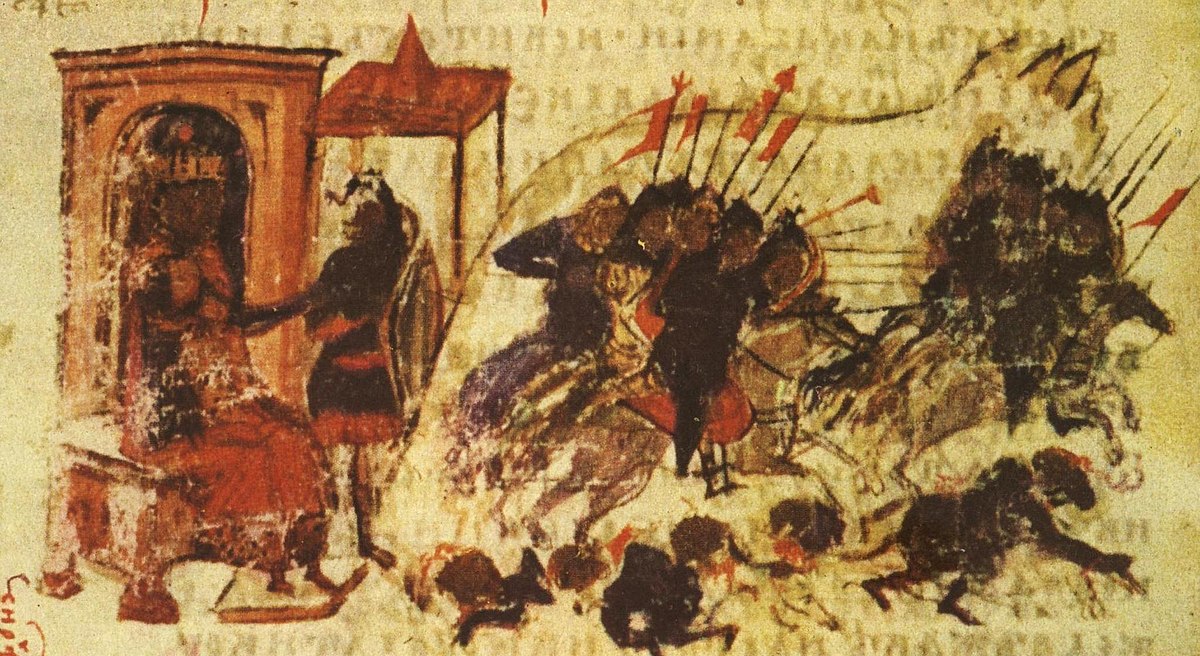The emperors immediately following Constantine were Arians until Theodosius I (r. 379-395), who in 381 proclaimed orthodox Nicene Athanasian Christianity to be the sole permitted state religion. All those who did not accept the Nicene Creed were to be driven from the cities of the Empire. The Empire, East and West, was united under Theodosius, but his sons Arcadius (r. 395-408) and Honorius (r. 395-423) divided it, with Arcadius ruling at Constantinople.
Until the accession of Justinian in 527, the eastern portion of the Empire successfully used Goths and other barbarians as troops and usually managed to deflect invaders further westward. Despite the challenge from Huns and Persians, the East continued to prosper. Only the monophysite controversy warned of internal weakness.
In an epic series of wars, Justinian’s armies reconquered North Africa from the Vandals, Italy from the Ostrogoths, and southern Spain from the Visigoths. It was a last desperate effort to reunite all of Rome’s Mediterranean lands. But the long campaigns and a vast new system of fortifications proved extremely costly. By limiting his wars with the Persians on the eastern frontiers to defensive efforts, Justinian permitted the Persian danger to grow.
The Empire did not have to pay the full bill for Justinian’s policies until the early seventh century. During the reign of Phocas I (r. 602-610), internal bankruptcy and external attacks from the Persians seemed to threaten total destruction. But Heraclius (r. 610-641) sailed in the nick of time from Carthage to Constantinople and seized the throne. He spent the first years of his reign in military preparations, absorbing heavy losses as the Persians took Antioch, Damascus, Jerusalem, and Alexandria. The Persians threatened Constantinople from the Asian side of the Straits, while the Slays and Avars were besieging it in Europe.
In 626 Heraclius defeated the Persians on their own territory and recaptured all the lost provinces. But only a few years later, the new movement of Islam exploded out of Arabia and overran the very provinces that Heraclius had recaptured from the Persians. In both the Persian and the Muslim victories over Byzantium, the antagonism of the monophysite Syrians and Egyptians played a major part. From Egypt the Muslims pushed westward to Carthage in 698, putting an end to Byzantine North Africa. Muslim ships began to operate from Cyprus and Rhodes. Heraclius’s work and that of Justinian were seemingly undone.
Despite the desperate crisis, the emperors completely overhauled the administrative machinery of the state. Gradually they extended the system of government previously introduced into Italy to their remaining territories in Asia Minor and the Balkans. The loss of Syria and Egypt required the transformation of Asia Minor into a reservoir of military manpower; the perpetual raids of Slays, Avars, and Bulgars into the Balkan provinces made the emergency more acute and increased still more the dependence on Asia Minor.
Eventually the emperors divided Asia Minor and the Balkans into army corps areas, with the local military commanders also exercising civil authority. These new military districts were called themes, from a word meaning permanent garrison. In each theme the troops were recruited from the native population; in return for their military services, the independent farmers were granted land, but they were not allowed to dispose of it or to evade their duties as soldiers. Their sons inherited the property along with the obligation to fight.
Though in theory responsible to the emperor, the commanding generals of the themes often revolted, and in the late seventh and early eighth centuries such rebellious generals seized the imperial throne. The imperial government strove to combat this danger by dividing the large original themes into smaller ones. From seven big themes at the end of the seventh century, the number mounted to about thirty smaller ones by the year 900.
This system embodied a change in concepts of taxation. As new immigration and settlement apparently ended the labor shortage of earlier centuries, it was now possible to separate the land tax from the tax on persons. The latter was transformed into a hearth tax, which fell on every peasant household without exception. For purposes of the land tax, each peasant village was considered a single unit. Imperial tax assessors regularly visited each village, calculated its total tax, and assessed each inhabitant a portion of it.
The community as a whole was held responsible for the total tax, and often the neighbor of a poor peasant or of one who had abandoned a farm would have to pay the extra amount to make up the total. This obligation was onerous, and when the tax could not be collected the state itself sometimes had to take over the property and resell or rent it. Displaced officials, overburdened landowners, and harried peasants weakened the idea of unity for a common purpose. Nonetheless, the Empire experienced sustained economic growth well into the twelfth century.

